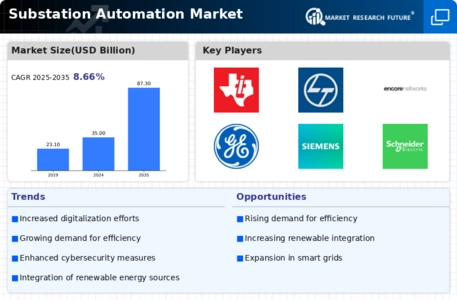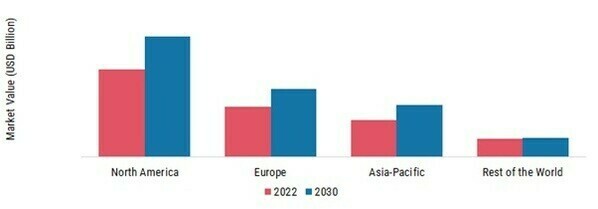-
Executive Summary
-
Scope of the Report
-
Market Definition
-
Scope of the Study
- Research Objectives
- Assumptions & Limitations
-
Markets Structure
-
Market Research Methodology
-
Research Module
-
Secondary Research
-
Primary Research
-
Forecast Model
-
Market Landscape
-
Porter’s Five Forces Analysis
- Threat of New Entrants
- Bargaining power of buyers
- Threat of substitutes
- Segment rivalry
-
Value Chain/Supply Chain of Global Substation automation Market
-
Industry Overview of Global Substation automation Market
-
Introduction
-
Growth Drivers
-
Impact analysis
-
Market Challenges
-
Market Trends
-
Introduction
-
Growth Trends
-
Impact analysis
-
Global Substation Automation Market By Component
-
Introduction
-
Recloser Controller
- Market Estimates & Forecast, 2025-2034
- Market Estimates & Forecast By Region, 2025-2034
-
Capacitor Bank Controller
- Market Estimates & Forecast, 2025-2034
- Market Estimates & Forecast By Region, 2025-2034
-
Smart Meter
- Market Estimates & Forecast, 2025-2034
- Market Estimates & Forecast By Region, 2025-2034
-
Load Tap Controller
- Market Estimates & Forecast, 2025-2034
- Market Estimates & Forecast By Region, 2025-2034
-
Others
- Market Estimates & Forecast, 2025-2034
- Market Estimates & Forecast By Region, 2025-2034
-
Global Substation Automation Market By Module
-
Introduction
-
SCADA
- Market Estimates & Forecast, 2025-2034
- Market Estimates & Forecast By Region, 2025-2034
-
Intelligent Electronic Device
- Market Estimates & Forecast, 2025-2034
- Market Estimates & Forecast By Region, 2025-2034
-
Communication Network
- Market Estimates & Forecast, 2025-2034
- Market Estimates & Forecast By Region, 2025-2034
-
Others
- Market Estimates & Forecast, 2025-2034
- Market Estimates & Forecast By Region, 2025-2034
-
Global Substation Automation Market By Communication Channel
-
Introduction
-
Ethernet
- Market Estimates & Forecast, 2025-2034
- Market Estimates & Forecast By Region, 2025-2034
-
Copper Wire Communication
- Market Estimates & Forecast, 2025-2034
- Market Estimates & Forecast By Region, 2025-2034
-
Power Line Communication
- Market Estimates & Forecast, 2025-2034
- Market Estimates & Forecast By Region, 2025-2034
-
Optical Fiber Communication
- Market Estimates & Forecast, 2025-2034
- Market Estimates & Forecast By Region, 2025-2034
-
Others
- Market Estimates & Forecast, 2025-2034
- Market Estimates & Forecast By Region, 2025-2034
-
Global Substation Automation Market By Industry
-
Introduction
-
Utility
- Market Estimates & Forecast, 2025-2034
- Market Estimates & Forecast By Region, 2025-2034
-
Transportation
- Market Estimates & Forecast, 2025-2034
- Market Estimates & Forecast By Region, 2025-2034
-
Mining
- Market Estimates & Forecast, 2025-2034
- Market Estimates & Forecast By Region, 2025-2034
-
Steel
- Market Estimates & Forecast, 2025-2034
- Market Estimates & Forecast by Region, 2025-2034
-
Others
- Market Estimates & Forecast, 2025-2034
- Market Estimates & Forecast by Region, 2025-2034
-
Global Substation automation Market by Region
-
Introduction
-
North America
- Market Estimates & Forecast, 2025-2034
- Market Estimates & Forecast by Component , 2025-2034
- Market Estimates & Forecast by Module, 2025-2034
- Market Estimates & Forecast by Industry, 2025-2034
- U.S.A
- Mexico
- Canada
-
Europe
- Market Estimates & Forecast, 2025-2034
- Market Estimates & Forecast by Component , 2025-2034
- Market Estimates & Forecast by Module, 2025-2034
- Market Estimates & Forecast by Industry, 2025-2034
- Germany
- France
- Italy
- U.K
-
8.1 Market Estimates & Forecast, 2025-2034
-
8.2 Market Estimates & Forecast by Component , 2025-2034
-
8.3 Market Estimates & Forecast by Module, 2025-2034
-
8.4 Market Estimates & Forecast by Industry, 2025-2034
-
Asia Pacific
- Market Estimates & Forecast, 2025-2034
- Market Estimates & Forecast by Component , 2025-2034
- Market Estimates & Forecast by Module, 2025-2034
- Market Estimates & Forecast by Industry, 2025-2034
- China
- India
- Japan
- Rest of Asia Pacific
-
Rest of the World
- Market Estimates & Forecast, 2025-2034
- Market Estimates & Forecast by Component , 2025-2034
- Market Estimates & Forecast by Module, 2025-2034
- Market Estimates & Forecast by Industry, 2025-2034
- The Middle East & Africa
- Latin Countries
-
Company Landscape
-
Company Profiles
-
Schneider Electric
- Company Overview
- Product/Business Segment Overview
- Financial Updates
- Key Developments
-
Siemens AG
- Company Overview
- Product/Business Segment Overview
- Financial Updates
- Key Developments
-
ABB Group
- Company Overview
- Product/Business Segment Overview
- Financial Updates
- Key Developments
-
General Electric
- Company Overview
- Product/Business Segment Overview
- Financial Updates
- Key Developments
-
Tropos Network
- Company Overview
- Product/Business Segment Overview
- Financial Updates
- Key Developments
-
EATON Corp.
- Company Overview
- Product/Business Segment Overview
- Financial Updates
- Key Developments
-
Encore Networks
- Company Overview
- Product/Business Segment Overview
- Financial Updates
- Key Developments
-
Grid Net
- Company Overview
- Product/Business Segment Overview
- Financial Updates
- Key Developments
-
Cooper Industries
- Company Overview
- Product/Business Segment Overview
- Financial Updates
- Key Developments
-
Larsen & Toubro Limited
- Company Overview
- Product/Business Segment Overview
- Financial Updates
- Key Developments
-
Power System Engineering, Inc.
- Company Overview
- Product/Business Segment Overview
- Financial Updates
- Key Developments
-
SAE IT-systems GmbH & Co. KG
- Company Overview
- Product/Business Segment Overview
- Financial Updates
- Key Developments
-
Others
- Company Overview
- Product/Business Segment Overview
- Financial Updates
- Key Developments
-
Conclusion
-
LIST OF TABLES
-
Global Substation automation Market: By Region, 2025-2034
-
North America Substation automation Market: By Country, 2025-2034
-
Europe Substation automation Market: By Country, 2025-2034
-
Asia Pacific Substation automation Market: By Country, 2025-2034
-
The Middle East & Africa Substation automation Market: By Country, 2025-2034
-
Latin America Substation automation Market: By Country, 2025-2034
-
Global Substation automation by Component Market: By Regions, 2025-2034
-
North America Substation automation by Component Market: By Country, 2025-2034
-
Europe Substation automation by Component Market: By Country, 2025-2034
-
Asia Pacific Substation automation by Component Market: By Country, 2025-2034
-
The Middle East & Africa Substation automation by Component Market: By Country, 2025-2034
-
Latin America Substation automation by Component Market: By Country, 2025-2034
-
Global Substation automation by Industry Market: By Regions, 2025-2034
-
North America Substation automation by Industry Market: By Country, 2025-2034
-
Europe Substation automation by Industry Market: By Country, 2025-2034
-
Asia Pacific Substation automation by Industry Market: By Country, 2025-2034
-
The Middle East & Africa Substation automation by Industry Market: By Country, 2025-2034
-
Latin America Substation automation by Industry Market: By Country, 2025-2034
-
North America Substation automation for Component Market: By Country, 2025-2034
-
Europe Substation automation for Component Market: By Country, 2025-2034
-
Asia Pacific Substation automation for Component Market: By Country, 2025-2034
-
The Middle East & Africa Substation automation for Component Market: By Country, 2025-2034
-
Latin America Substation automation for Component Market: By Country, 2025-2034
-
Global Component Market: By Region, 2025-2034
-
Global Component Market: By Region, 2025-2034
-
Global Component Market: By Region, 2025-2034
-
North America Substation automation Market, By Country
-
North America Substation automation Market, By Component
-
North America Substation automation Market, By Component
-
North America Substation automation Market, By Industry
-
Table31 Europe: Substation automation Market, By Country
-
Europe: Substation automation Market, By Component
-
Europe: Substation automation Market, By Component
-
Europe: Substation automation Market, By Industry
-
Asia Pacific: Substation automation Market, By Country
-
Asia Pacific: Substation automation Market, By Component
-
Asia Pacific: Substation automation Market, By Component
-
Asia Pacific: Substation automation Market, By Industry
-
The Middle East & Africa: Substation automation Market, By Country
-
The Middle East & Africa Substation automation Market, By Component
-
The Middle East & Africa: Substation automation Market, By Component
-
The Middle East & Africa: Substation automation Market, By Industry
-
Latin America: Substation automation Market, By Country
-
Latin America Substation automation Market, By Component
-
Latin America: Substation automation Market, By Component
-
Latin America: Substation automation Market, By Industry
-
LIST OF FIGURES
-
Global Substation automation market segmentation
-
Forecast Methodology
-
Five Forces Analysis of Global Substation automation Market
-
Value Chain of Global Substation automation Market
-
Share of Global Substation automation Market in 2023, by country (in %)
-
Global Substation automation Market, 2025-2034,
-
Sub segments of Component
-
Global Substation automation Market size by Module , 2023
-
Share of Global Substation automation Market by Component , 2025-2034
-
Global Substation automation Market size by Module , 2023
-
Share of Global Substation automation Market by Component , 2025-2034
-
Global Substation automation Market size by Module, 2025-2034
-
Global Substation automation Market size by Module, 2025-2034
-
Share of Global Substation automation Market by Module, 2025-2034

 Source: Secondary Research, Primary Research, MRFR Database, and Analyst Review
Source: Secondary Research, Primary Research, MRFR Database, and Analyst Review














Leave a Comment